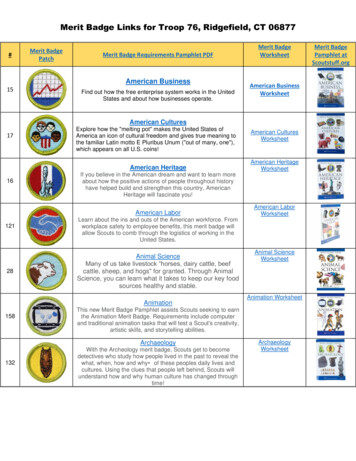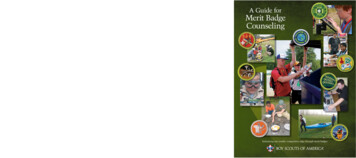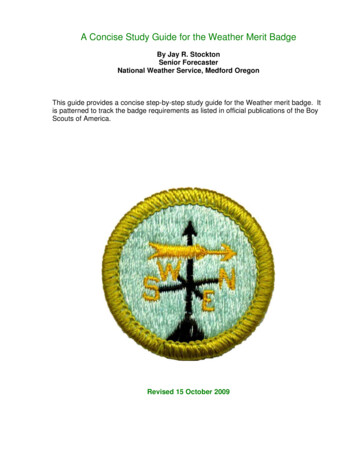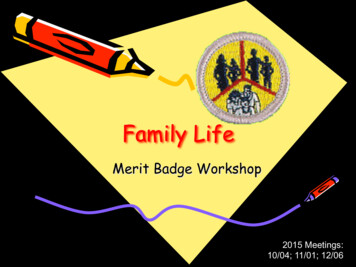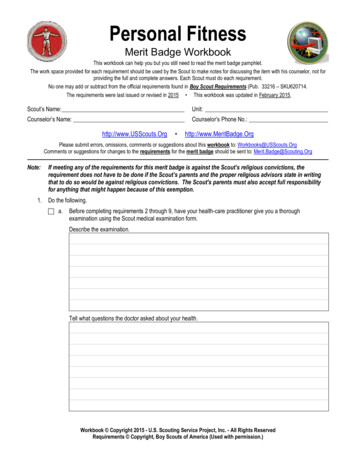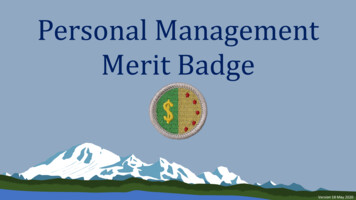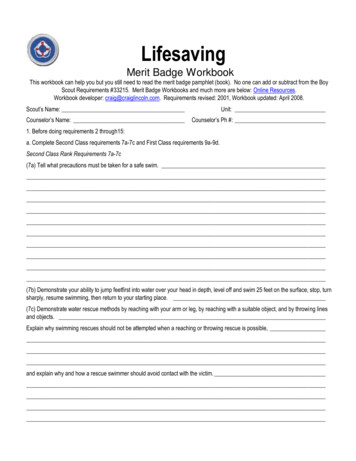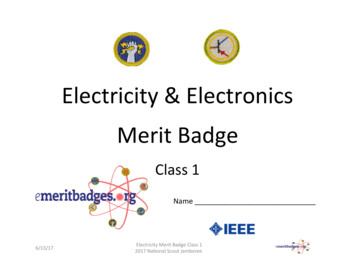
Transcription
Electricity & ElectronicsMerit BadgeClass 1Name6/13/17Electricity Merit Badge Class 12017 Na onal Scout Jamboree
Types of ElectricitySta c ElectricitySta c electricity is usually createdwhen materials are pulled apart orrubbed together, causing posi ve ( )charges to collect on one materialand nega ve ( ) charges on the othersurface. Sparks may result!Examples of occurrence of sta celectricity:1.2.3.4.Lightning.Combing hair.Walking across carpet andgeUng shocked.Pulling out scotch tape. Electricity Merit Badge Class 16/13/172017 Na onal Scout Jamboree
Types of ElectricityDirect Current (DC)Type of electricity used in most, if notall electronics we have today.Current only flows in one direc on(not both direc ons, like AC).Examples of DC usage:1.2.3.4.MP3 playersRadiosElectricity in cars.Anywhere you use a ba\ery forpower.6/13/17Electricity Merit Badge Class 12017 Na onal Scout Jamboree
Types of ElectricityAlterna ng Current (AC)The common form of electricity frompower plant to home/office. Itsdirec on is reversed 60 mes persecond in the U.S.; 50 mes inEurope.Examples of AC usage:1.2.3.4.Kitchens: Stoves, ovens, mixer,etc.Computer chargersLights in houseHome air condi oners.6/13/17Electricity Merit Badge Class 12017 Na onal Scout Jamboree
Voltage Volts is the electromo ve force that causeselectrons (current) to flow. Voltage can also be thought of as the electricalforce that pushes electrons in a wire. Units for voltage is VOLTS. The symbol for voltage is E. The schema c symbol for dc voltage isgenerally shown as a ba\eryGND6/13/17Electricity Merit Badge Class 12017 Na onal Scout Jamboree
Voltage – Water AnalogySmall height low voltageBig height high voltageheightheight1. Gravity provides the force for water(current) to flow.2. This illustrates a small voltage, so currentflow is small.3. You can increase water (current) flow bymaking the pipe larger as well.6/13/171. Gravity provides the force for water(current) to flow.2. This illustrates a larger voltage, so currentflow is larger.3. You can increase water (current) flow bymaking the pipe larger as well.Electricity Merit Badge Class 12017 Na onal Scout Jamboree
Current Current: Defined as “flow( me rate ofchange) of electrons”. Current: Units of current is AMPS. Current: Electrical symbol for current is I (eye).6/13/17Electricity Merit Badge Class 12017 Na onal Scout Jamboree
Current Flow – Water Analogy1. Water flows in the hose, entering at the top andexi ng the bo\om.2. The water is the “current” ; the flow of electrons.3. The more water flowing in the pipe, the more currentis flowing in the wire.4. Different pipe diameters illustrates differentresistance to water flow, which correlates to differentresistor values.6/13/17Electricity Merit Badge Class 12017 Na onal Scout Jamboree
Resistance Resistance is the electrical property of asubstance to resist the flow of electrons. The units of resistance is OHMS (Ω). The symbol for resistance is R. The schema c symbol is The larger the resistance, the more resistanceto current flow.6/13/17Electricity Merit Badge Class 12017 Na onal Scout Jamboree
Resistance – Water Analogy Different pipe diametersrepresents differentresistor values.The smaller the diameter ofthe pipe, the larger tricity Merit Badge Class 12017 Na onal Scout Jamboree
Electrical Terms Circuit-A conductor or system path of electricalelements through which current will flow. Poten al Difference-The Voltage between twopoints in a circuit. Impedance-The term used in AC Circuits for theresistance to the flow of current. Short Circuit-An abnormal connec on of lowimpedance (resistance) between two points ofdifferent poten al. Ground-A point of common connec on of zerovolts oren the earth6/13/17Electricity Merit Badge Class 12017 Na onal Scout Jamboree
Other Electrical Terms Wa\- Power to do work at 1 joule/sec orW VxI Rec fier-Electronic or Mechanical means toconvert AC to DC. Rheostat-An adjustable resistance such thatresistance can be changed without breakingthe circuit(example light dimmer). Conductor-Material that will allow current topass con nuously along it (wire).6/13/17Electricity Merit Badge Class 12017 Na onal Scout Jamboree
Other Electrical Terms Switch-Electronic or Mechanical means foropening and closing a circuit. Fuse-A device that protects a circuit from overcurrent by mel ng a link in the device. Circuit Breaker-A device that protects a circuit forover-current by opening the circuit with a switch. Cycle-One complete reversal of alterna ngcurrent or voltage. Hertz-One cycle per second6/13/17Electricity Merit Badge Class 12017 Na onal Scout Jamboree
Equipment Used To Measure ElectricalQuan es and Quali esVolt/Ohm/Amp MeterUsually referred to as a mul -meter.With this we can measure current A, voltageV and resistance R.OscilloscopeUsually referred to as a Scope or OScopeWith this we can ‘see’ voltage waveforms. This is very useful whenvoltage is changing, as a meter is nogood to us when this is happening.6/13/17Electricity Merit Badge Class 12017 Na onal Scout Jamboree
Ohms Law DC CircuitsVolts Current x Resistance E IxR Units– E is in Volts– I the electrical current is in Amps– R is Resistance is in OhmsExample: If the Voltage E stays the SAME andResistance R goes UP, then the amount of Current Iflowing in the circuit goes DOWN6/13/17Electricity Merit Badge Class 12017 Na onal Scout Jamboree
Electricity and Electronic SymbolsSingle Pole, Double Throw Switch (SPDT)Ba\eryorCapacitorResistorLight EmiUng Diode (LED)BuzzerFuseLamp6/13/17Electricity Merit Badge Class 12017 Na onal Scout JamboreeGround
CIRCUIT DIAGRAM (SCHEMATIC)FLASHLIGHTLAMP10 OhmsSWITCH Calculate IV 9 VoltsR 10 OhmsI ? AmpsIV 9VGROUNDV IxRGROUND9 V I A x 10 Ohms9 V / 10 Ohms I Amps0.9 Amps ITWO GROUND SYMBOLS IS THE SAME AS CONNECTING WITH A WIREGROUND 0 VOLTS6/13/17Electricity Merit Badge Class 12017 Na onal Scout Jamboree
Electricity Safety High Voltage ( 120V AC or greater) – Safetymainly about not touching the wrong thing. Current kills – Only 60 volts can kill when currentflows through heart or head for a sufficientlength of me. Ventricular fibrilla on - Current passing throughheart causes knocks heart out of synchroniza on. If the shock doesn’t kill you, you can s ll bebadly burned from touching the wrong thing.6/13/17Electricity Merit Badge Class 12017 Na onal Scout Jamboree
Electric Shock If a person is in contact with an energized(live) circuit do not touch them.– Turn off the breaker.– If you do not know where the breaker is locatedpush the circuit off of the person with a dry objectlike a broom, mop handle or wooden chair.– Do not use any object that is metal or wet.– Water like metal can conduct electricity inamounts that can be dangerous.6/13/17Electricity Merit Badge Class 12017 Na onal Scout Jamboree
Removal of Live Wire If you cannot remove the wire with a dryobject or turn off the breaker then:– Be sure you are on a dry surface and– Find a dry shirt, sheet or sweater and loop itaround the wire and pull it off– Or in case you cannot get to the wire try the samemethod to pull the person off the wire.– Once you have a person away from the wirescheck to see if they need ar ficial respira on.6/13/17Electricity Merit Badge Class 12017 Na onal Scout Jamboree
High Power Lines If a person is in contact with high power lines:– Do not touch them.– Stay at least 20 feet away as current can flowthrough the ground.– Call 911.– Let the fire and police manage the situa on.6/13/17
Power Lines6/13/17Electricity Merit Badge Class 12017 Na onal Scout Jamboree
Trea ng Electrical Burns When a person has a severe electrical burn:– Do not apply ice, ointment, water, medica on,bandages or dressings– Do not touch or break boils or blisters– Do not a\empt to remove clothing6/13/17
Electrical Storms About 54 people are killed from lightning everyyear and several hundred are injured. Numerous forest and house fires are started bylightning. If outdoors avoid tall solitary trees, towers,water, mountain tops and ridge crests, metalfences and any object like a metal tent pole. The safest place is a dense forest in a low lyingarea. If caught in the open stay low, spread out, crouchwith both feet together and soles on the ground6/13/17Electricity Merit Badge Class 12017 Na onal Scout Jamboree
Electrical Fires They are different from other fires in that trying to putout a fire:Never use water.Call 911.Turn off main breakerUse only ex nguishers rated for fires. Class Cfires involve electrical equipment, such as appliances,wiring, circuit breakers and outlets. Never use water - therisk of electrical shock is far too great! The C classifica onmeans the ex nguishing agent is non-conduc ve.Geometric symbol (blue circle)– If fire does not go out leave the building.––––6/13/17Electricity Merit Badge Class 12017 Na onal Scout Jamboree
Personal Safety Be aware of what you are doing, and where you areplacing equipment and yourself in an electrical circuit. Pay a\en on to energized circuits – Is the power on?Make sure the electricity is turned off especially whenworking on 120 VAC or higher electrical circuits. Pay a\en on to hot soldering irons. Keep a gooddistance between you those next to you. Know when you are working with high current and/orhigh voltage circuits. THINK before you do something. Wear safety glasses when soldering.6/13/17Electricity Merit Badge Class 12017 Na onal Scout Jamboree
How to avoid shock. Turn power off before working on equipment. Don’t touch circuits that could have high voltage on them. Do not allow current to flow through heart (or maybemouth, in this case of an electrified fence).6/13/17Electricity & Electronics Merit Badges Class1 – 2013 Na onal Scout Jamboree
Sample Home Electrical Inspec onChecklist Outletsχ Check for outlets that have loose-fiUng plugs, which can overheat and lead to fire.χ Replace any missing or broken wall plates.χ Make sure there are safety covers on all unused outlets that are accessible to children.Line Cordsχ Make sure cords are in good condi on-not frayed or cracked.χ Make sure they are placed out of traffic areas.χ Make sure that cords are not nailed or stapled to the wall, baseboard or to another object.χ Make sure that cords are not under carpets or rugs or any furniture rests on them.Extension Cordsχ Check to see that extension cords are not overloaded & only be used on a temporary basis, not as permanent wiring.χ Make sure extension cords have safety closures to help protect children from shock hazards and mouth burns.Plugsχ Make sure your plugs fit securely into your outlets.χ Make sure no plugs have had the ground pin (the third prong) removed in order to make a three-prong fit a two-conductoroutlet; this could lead to an electrical shock.χ Never force a plug into an outlet if it doesn't fit.χ Avoid overloading outlets with too many appliances.Ground Fault Circuit Interrupters (GFCIs)GFCIs can help prevent electrocu on. When a GFCI senses current leakage in an electrical circuit, it assumes a ground fault hasoccurred. It then interrupts power fast enough to help prevent serious injury from electrical shock. GFCIs can be installed at theoutlet, or as a replacement for the circuit breaker for an en re circuit at the fuse box.χ Kitchen χ Bathrooms χ Garage χ Laundry room χ Outdoorsχ Test GFCIs according to the manufacturer's instruc ons monthly and arer major electrical storms to make sure they areworking properly.6/13/17Electricity Merit Badge Class 12017 Na onal Scout Jamboree
Sample Home Electrical Inspec onChecklist Light Bulbsχ Check the wa\age of all bulbs in light fixtures to make sure they are the correct wa\age for the size of the fixture.χ Replace bulbs that have higher wa\age than recommended; if you don't know the correct wa\age, check with themanufacturer of the fixture.χ Make sure bulbs are screwed in securely; loose bulbs may overheat.Circuit Breakers/Fusesχ Make sure circuit breakers and fuses are the correct size current ra ng for their circuit. If you do not know the correct size,have an electrician iden fy and label the size to be used. Always replace a fuse with the correctly specified size fuse.χ Make sure everyone in your home knows where the main breaker is located and how to shut of power to the en re house.Plug In Appliancesχ Make sure there are no plugged-in appliances where they might fall in contact with water. If a plugged-in appliance falls intowater, NEVER reach in to pull it out—even if it's turned off. First turn off the power source at the panel board and thenunplug the appliance. If you have an appliance that has go\en wet, don't use it un l it has been checked by a qualified repairperson.Appliancesχ If an appliance repeatedly blows a fuse, trips a circuit breaker or if it has given you a shock, unplug it and have it repaired orreplaced.Entertainment/Computer Equipmentχ Check to see that the equipment is in good condi on and working properly. Look for cracks or damage in wiring, plugs andconnectors.χ Use a surge protector bearing the seal of a na onally recognized cer fica on agency.6/13/17Electricity Merit Badge Class 12017 Na onal Scout Jamboree
Sample Home Electrical Inspec onChecklist Outdoor Safetyχ Electric-powered mowers and other electric tools should not be used in the rain, on wet grass or in wet condi ons.χ Inspect power tools & electric lawn mowers before each use for frayed power cords, broken plugs & cracked or brokenhousings. If any part is damaged, stop using it immediately. Repair it or replace it.χ Always use an extension cord marked for outdoor use and rated for the power needs of your tools.χ Remember to unplug all portable power tools when not in use.χ When using ladders, watch out for overhead wires and power lines. Stay at least 10 feet from all overhead lines.Lightningχ During an electrical storm, do not use appliances (i.e., hairdryers, toasters and radios) or telephones (except in anemergency); do not take a bath or shower;χ Keep ba\eries on hand for flashlights and radios in case of a power outage.χ Use surge protectors on electronic devices, appliances, phones, fax machines and modems.Space Heatersχ Space heaters are meant to supply supplemental heat. Keep space heaters at least 3 r. away from any combus blematerials such as bedding, clothing, draperies, furniture and rugs.χ Don't use space heaters in rooms where children are unsupervised and remember to turn off and unplug when not in use.χ Do not use space heaters with extension cords; plug directly into an outlet on a rela vely unburdened circuit.Halogen Floor Lampsχ Halogen floor lamps operate at much higher temperatures than a standard incandescent light bulb. Never place a halogenfloor lamp where it could come in contact with draperies, clothing or other combus ble materials.χ Be sure to turn the lamp off whenever you leave the room for an extended period of me.χ Never use torchiere lamps in children's bedrooms or playrooms. Consider using cooler fluorescent floor lamps.6/13/17Electricity Merit Badge Class 12017 Na onal Scout Jamboree
How can we save energy in our homes,schools and scout areas Turn off unneeded or unused lights Unplug chargers when not in use charging When appliances need to be replaced buyenergy star appliances In the summer set the indoor temperature adegree or two higher and in winter a degreeor two lower Turn off the TV when leaving the room6/13/17Electricity Merit Badge Class 12017 Na onal Scout Jamboree
How can we save energy in our homes,schools and scout areas Plan trips to the store so that one trip cancomplete several errands Don’t exceed the speed limit Use a bike for short trips rather than a car Make sure that the building has adequateinsula on Stop all air leaks in a building use infraredscanner to find leaks6/13/17Electricity Merit Badge Class 12017 Na onal Scout Jamboree
How can we save energy in our homes,schools and scout areas Clean or replace air filters regularlyUse energy efficient light bulbsKeep the doors closed when cooling or hea ngShade your windows in the summerUse ceiling fansClose all fireplace flues when not in useWash only full loadsSet washers on economy load to save water6/13/17Electricity Merit Badge Class 12017 Na onal Scout Jamboree
How can we save energy in our homes,schools and scout areas Set water temperature lower Take shorter showers Don’t let the water run while brushing orshaving Look for energy efficient computers and TVs Unplug unused appliances and devices as theyuse power at all mes6/13/17Electricity Merit Badge Class 12017 Na onal Scout Jamboree
Electricity & Electronics Merit Badges Class 1 – 2013 Naonal Scout Jamboree How to avoid shock. Turn power off before working on equipment. Don’t touch circuits that could have high voltage on them. Do not allow current to flow through heart (
